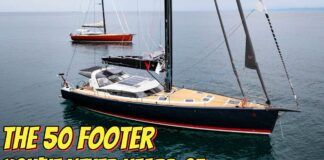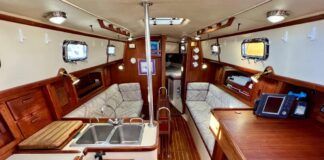When it comes to snubber sizes and diameters, catamarans present special challenges, and usually require a bridle, with separate lines leading from the hook to each hull. Heres an example of the bridle-type snubber that PS contributor Jonathan Neeves uses on his seven-ton, 38-foot catamaran that he lives aboard and cruises in Australia.
On most catamarans, the snubber is a bridle that extends outward from the bow crossbeams and attaches to the anchor. Our bridle is formed using two, 50-foot lengths of lightly used, 11-millimeter climbing rope (selected for its abrasion resistance and elasticity) that are attached to horn cleats on the stern. (The equivalent would be 12-millimeter nylon three-strand braid or eight-strand plait, either of which would serve well.)
We run the snubber up the sidedecks and through the stanchion bases. The legs of each bridle then pass through swivel blocks shackled to padeyes that we have installed at each bow. Although each snubber is 50 feet long, we use only about 30 feet; the rest is in reserve.

The individual snubber legs are joined at a shackle with scaffold or halyard knots (climbing rope is impossible to splice). The only tricky part of the installation is reinforcing the area where the padeyes are located. An alternative to the padeyes is to fit the blocks to the forward horn cleats. (We used to do this, securing the blocks with a length of nylon webbing so that they hung outboard.)
The same system can easily be adopted for a monohull that uses a single snubber. The main variable is how to direct the snubber from the sidedeck to the chain hook. This will depend on the individual yacht, but fairleads would be an attractive option, probably requiring some form of chafe protection.
If you have a beamy or heavy monohull, a bridle can be more effective at reducing yawing, and yawing can exacerbate snatch loads. The amount of time you invest in developing a sensible system will depend on how much time you spend at anchor. We can be at anchor for three to five months each year, so we wanted something permanent.





































